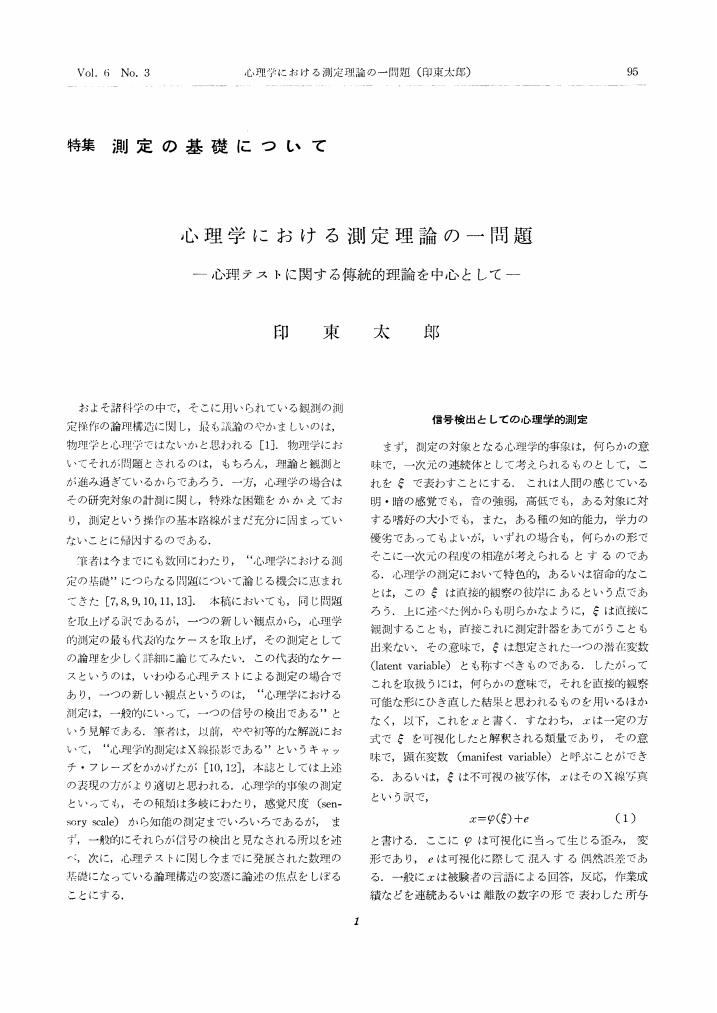3 0 0 0 OA 数理心理学
- 著者
- 印東 太郎
- 出版者
- 公益社団法人 計測自動制御学会
- 雑誌
- 計測と制御 (ISSN:04534662)
- 巻号頁・発行日
- vol.15, no.10, pp.801-810, 1976-10-10 (Released:2009-11-26)
- 参考文献数
- 28
2 0 0 0 OA 輝度の加法性について 色彩スケール論 3(横山松三郎先生古稀記念論文集)
- 著者
- 印東 太郎
- 出版者
- 慶應義塾大学
- 雑誌
- 哲學 (ISSN:05632099)
- 巻号頁・発行日
- vol.38, pp.281-306, 1960
横山松三郎先生古稀記念論文集一. 緒言二. 問題の所在三. 加法性に関する実験四. 結語As one of the treatises in a continued series making inquiries into psychological problems involved in photometry and colorimetry, the present article provided a detailed account of all the postulates inherent in the present definition of the psychophysical concept: light. In regard to the C.I.E. luminosity curve, discussions were made about individual differences in its source data, the psychophysical procedures employed, restrictions in the observational conditions and so on, but special emphasis is laid on the role played by Abney's law, i.e., the additivity of luminance. Hence, results of the recent experiments made by MacAdam, Sperling, Fedorov etc., which concern directly or indirectly with the additivity assumption, were reviewed with the conclusions as follows. If Abney's law holds at all, it does only under luminance matches by the flicker method. Direct comparison methods do not consistently support the precise additivity of luminance The additivity principle, however, underlies all the present systems of photometry and colorimetry. Nevertheless, the flicker method could not reasonably be accepted as the sole basis for photometric meaurements to the exclusion of direct observations. Though useful, the flicker photometry is a secondary procedure in the sense that it is less closely related to ordinary conditions of observing colors. Photometry and colorimetry have served more than thirty years for practical purposes with no serious trouble, which would indicate that the deviations from additivity be of the magnitude that can be tolerated in ordinary situations where colors are under direct observation but no direct comparison is involved. Hence, textbooks are warranted in taking the additivity principle for granted. From the viewpoint of psychophysics, howe, it might be of importance to make clear the abney's law has been established accurately only by the flicker method. It was argued that luminance is ultimately based on the determination of the equality in brightness and remains to be the lower metric of brightness even when it is defined with internal consistency. Higher metric should answer the question by how many times one brightness differs from another.
1 0 0 0 OA 心理学における測定理論の一問題 心理テストに関する傳統的理論を中心として
- 著者
- 印東 太郎
- 出版者
- 科学基礎論学会
- 雑誌
- 科学基礎論研究 (ISSN:00227668)
- 巻号頁・発行日
- vol.6, no.3, pp.95-104, 1963 (Released:2009-09-04)
- 参考文献数
- 29
1 0 0 0 OA 心理学における空間概念
- 著者
- 印東 太郎
- 出版者
- 科学基礎論学会
- 雑誌
- 科学基礎論研究 (ISSN:00227668)
- 巻号頁・発行日
- vol.6, no.2, pp.47-55, 1963-01-20 (Released:2010-01-22)
- 参考文献数
- 40
1 0 0 0 OA アイソモルフィズムの一問題 : 知覺された点の位置について
- 著者
- 印東 太郎
- 出版者
- 慶應義塾大学
- 雑誌
- 哲學 (ISSN:05632099)
- 巻号頁・発行日
- vol.27, pp.205-241, 1951-08
序. 問題の所在第I章. 受容器の同一点に与えられた近刺戟によるパァセプトも、その受容器の物理的身体に対する位置を異にするにつれ、現象空間で心理的身体に対し異なる位置に現れる事の証明第II章. 異質同形説による考察文献The main tenets of-isOmorphism may be stated briefly as follows: (1) Due to the physico-chemical nature of the cerebral-cortex, the physiological process that taken place in it must necessarily have a macroscopic structure or, in a word, a "physische Gestalt." (2) Since conscious phenomena and physiological frocesses are realities of different ,order, their "correlates" cannot be icieniical or similar to each other in quality, nevertheless, they must be identical or similar in their macroscopic structure. Applying the above theory to, explain the following fact, I tried to see what results may come: out and 'what new problems are likely to be raised. Example-Suppose you stimulate two points, A and B on the hanging arm, in which A is nearer to the wrist than B, then A will be felt in the position lower than B; while in the case of the arm raised, A will be' felt in the position above B. This should be explained, as Kohler has insisted, by differentiating the psychological body from the physical one, and by considering the functional relationship of the position with respect to the "limb coordinates" and the "ego coordinates" in the psychological body. In general, the percept resulting from the proximal stimulus given to a point in the receptor will appear in a position with respect to the psychological body in a phenorrienal space different from one resulting from the same proximal stimulus given to the same point in the receptor, if the position of the receptor in relation to the physical body is different in the two cases. This principle can be applied also to the auditory and visual senses. The conclusiorr warranted may be summarized in the following two propositions: Proposition I. The position of the tactual point with respect to the "limb coordinates" and the "ego coordinates" is felt directly and spontaneously. Proposition II. The position of a luminous point with respeet to the "vision coordinates" and the "ego coordinates" is felt directly and spontaneously. From thelpoint of view of isomorphism the above propositions may be transformed into the following statement: Proposition III. The "psychophysical correlate" resulting from the proximal stimulus given to a point in the receptor Will have a position in the psychophysical level relative to the correlate of the trunk. These propositions lead to a further proposition concerning the position of the percept in the phenomenal space. Making a diagram to illustrate these propositions and examining the results of the experiments done by Lauenstein, Jacobs, Amano and myself, I tried to arrange the psychological facts in order, preparing for the future development of physiology.




